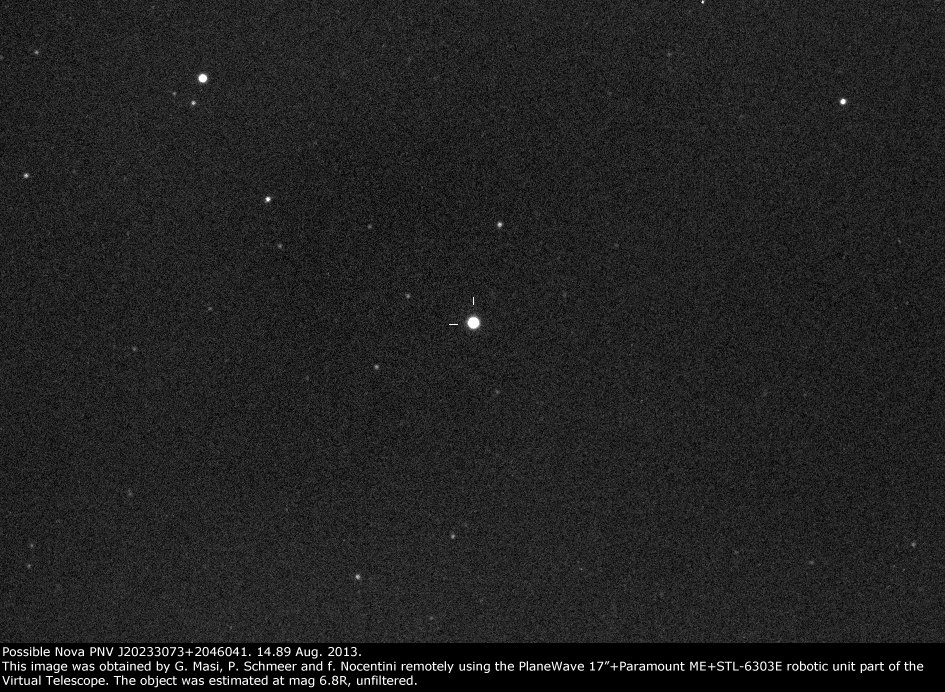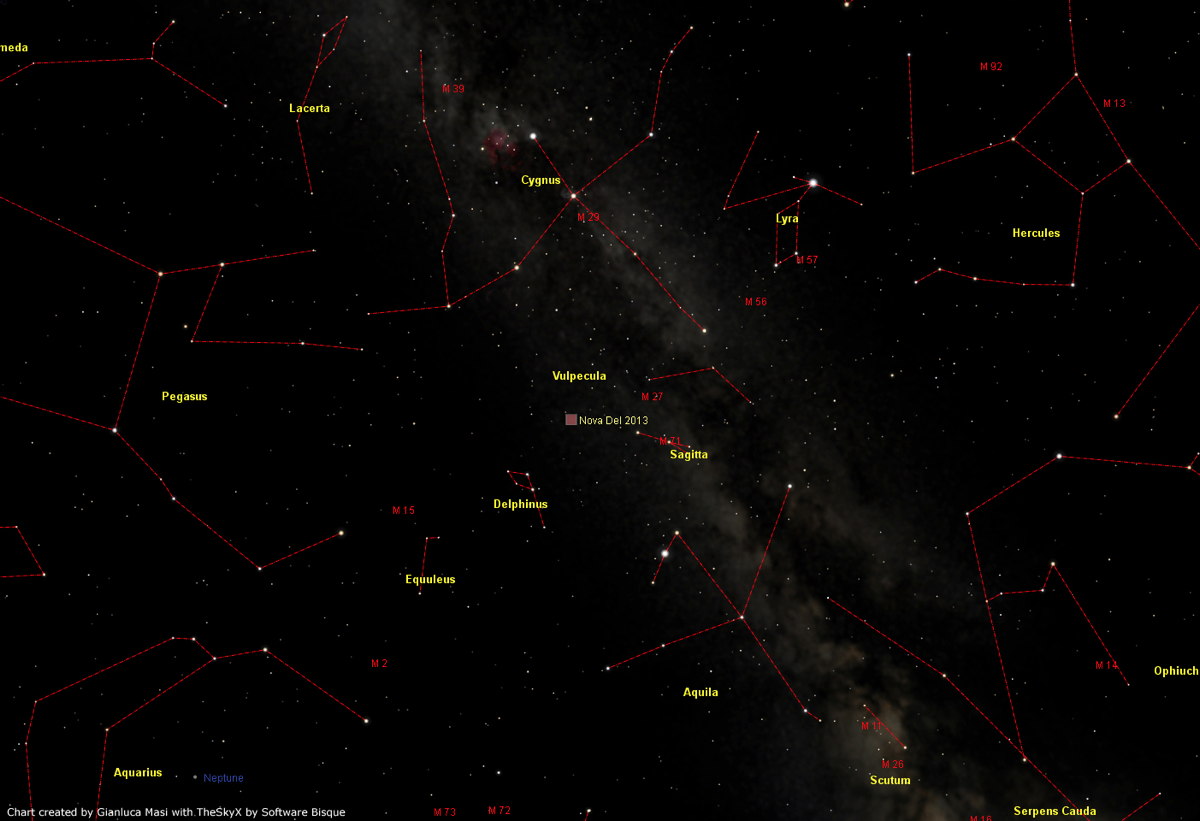New 'Nova' Star Explosion Spotted in Night Sky: How to See It

A new star explosion, called a nova, has flared up in the night sky, and it is fairly easy to spot with binoculars — and potentially even the naked eye — by stargazers with clear weather and dark skies. You can even see the new nova online tonight in a skywatching webcast.
Called Nova Dephinus 2013, the new nova (Latin for "new star") was discovered Wednesday (Aug. 14) by amateur astronomer Koichi Itagaki of Yamagata, Japan, at 2 p.m. EDT (1800 GMT) in the constellation Delphinus, the Dolphin. Itagaki used a CCD camera attached to a 7-inch reflecting telescope. A nova is a powerful eruption from star, but is not as strong as a supernova, which is a catastrophic explosion that signals the death of a star.
Weather permitting, you can see the star explosion in a webcast on SPACE.com tonight, courtesy of the online Slooh Space Camera. The webcast will begin at 7 p.m. EDT (2300 GMT) and feature views of Nova Delphinus 2013 from the Canary Islands off the western Africa coast. [See photos and sky maps of the new nova star explosion]
"Slooh members have already imaged the nova, and it looks amazing," Slooh President Patrick Paolucci told SPACE.com.
The new nova's visual magnitude was estimated at +6.8, meaning it was just below the threshold of visibility with the naked eye on the magnitude scale used by astronomers to measure brightness of night skyobjects. (The lower the number, the brighter the object.)
The new nova was not present in a photo taken by Itagaki on Tuesday (Aug. 13), when he observed stars down to a magnitude +13, so overnight it had brightened at least 300-fold. More likely, however, it initially was much dimmer — perhaps as faint as magnitude +17, implying that in less than 24 hours it may have increased in brightness by more than 10,000 times!
I was able to view the nova from my home in Putnam County, N.Y. just before midnight on Wednesday night with 7x35 binocularsand estimated its brightness at magnitude +6. So since its discovery some 10 hours earlier, the nova had doubled in apparent brightness, and it might continue to get even brighter over the next day or two.
Breaking space news, the latest updates on rocket launches, skywatching events and more!
How to see the new nova
Nova Delphinus 2013 is located within the boundaries of the small constellation of Delphinus, the Dolphin, which is immediately adjacent to the famous Summer Triangle composed of the bright stars Vega, Altair and Deneb. Delphinus is recognized for a small diamond of four moderately dim stars that are sometimes referred to as "Job's Coffin."
Astrophysicist Gianluca Masi, who oversees the online Virtual Telescope Project for stargazing, snapped images of the new nova and plotted its position in sky maps.
"This nova is now close in brightness to the faintest stars visible with the naked eye from a dark place. It is a very easy object with a small pair of binoculars or a little telescope," Masi wrote on the Virtual Telescope Project website.
The nova is situated roughly 5 degrees above the diamond (your clenched fist held at arm's length measures roughly 10 degrees). Near Delphinus is the similarly small and dim constellation of Sagitta, the Arrow. By coincidence, the arrowhead of this star pattern seems to be pointing almost directly at the nova.
As darkness falls around 9:30 p.m. local time, Delphinus can be found high in the southeast sky. It reaches its highest point about two-thirds up from the southern horizon to the overhead point (called the zenith) at midnight and is still visible about one-third up from the western horizon as dawn is breaking (at around 5 a.m. local time). So currently you can actively search for the nova at any time during the course of the night, as it will always be above the horizon.
Nova vs. supernova
You may have have heard of the terms "nova" and "supernova," but they refer to two completely different phenomena of star evolution.
What we see as a nova is believed to originate from the surface of a white dwarf star in a binary system. If these two stars are close enough, material from one star can be pulled off the companion star's surface and onto the white dwarf, producing an extremely bright outburst of light.
When the outburst has subsided, the white dwarf usually reverts back to its original state. This likely is the case for the nova discovered in Delphinus. Interestingly, we have observed stars that have gone through such contortions more than once.
But there is no second time for a supernova.
In a supernova scenario, a star, far more massive than our sun and nearing the end of its life, suddenly blows itself apart and in the process briefly shines with an apparent brilliance of more than 100 billion normal stars! [Spectacular Supernova Photos of Star Deaths (Gallery)]
How common are novas?
Bright naked-eye novas appear perhaps once or twice per decade.
During the last 50 years, the brightest nova that has appeared occurred in August 1975, when a nova suddenly blazed in the constellation of Cygnus, the Swan. It reached magnitude +1.8 — brighter than Polaris, the North Star, though not quite as bright as first-magnitude Deneb, the brightest star in Cygnus.
The last naked-eye supernova to flare in our galaxy appeared in the constellation Ophiuchus in the year 1604 and equaled or rivaled the planet Jupiter in brightness. We are overdue for another.
Shades of '67
The announcement of a nova in Delphinus stirred up a childhood memory for me. Back in the summer of 1967, when I was a budding young amateur astronomer living in The Bronx, N.Y., a nova appeared in Delphinus, not far from where our current nova now resides. After its discovery in July 1967, Nova Delphini vacillated between magnitude 4.5 and 5.5.
By mid-September, the star seemingly leveled off at around fifth magnitude, but then suddenly in mid-December its brightness unexpectedly spiked at magnitude 3.5, making it a rather easy naked-eye object before it faded just as rapidly by year's end.
What will this latest version of a nova in Delphinus do? We really don't know, but it certainly will be something worth monitoring in the days and weeks to come.
You can watch the Slooh webcast of Nova Delphinus 2013 directly on the Slooh website at: http://www.slooh.com
Editor's Note: If you snap an amazing picture of the new nova star explosion, or any other night sky view that you'd like to share for a possible story or image gallery, send photos, comments and your name and location to managing editor Tariq Malik at spacephotos@space.com.
Joe Rao serves as an instructor and guest lecturer at New York's Hayden Planetarium. He writes about astronomy for Natural History magazine, the Farmer's Almanac and other publications, and he is also an on-camera meteorologist for News 12 Westchester, N.Y. Follow us @Spacedotcom, Facebookand Google+. Original article on SPACE.com.

Joe Rao is Space.com's skywatching columnist, as well as a veteran meteorologist and eclipse chaser who also serves as an instructor and guest lecturer at New York's Hayden Planetarium. He writes about astronomy for Natural History magazine, Sky & Telescope and other publications. Joe is an 8-time Emmy-nominated meteorologist who served the Putnam Valley region of New York for over 21 years. You can find him on Twitter and YouTube tracking lunar and solar eclipses, meteor showers and more. To find out Joe's latest project, visit him on Twitter.


